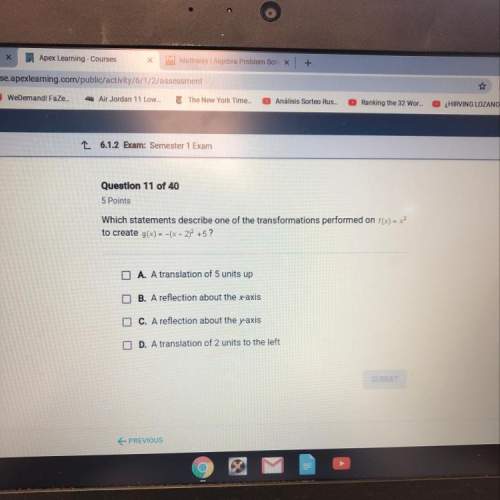
Mathematics, 29.07.2020 23:01 ella3714
Part 1: True- False 1. In the field of statistics, descriptive statistics includes collecting and describing data while inferential statistics involves interpreting results from the data. 2. A population is the complete collection of individuals or objects or events whose properties are to be analyzed. 3. A variable is a characteristic of interest about each individual element of a population or sample. 4. A population is typically a very large collection of individuals or objects about which we desire information. 5. The mean, median and mode are three measures of central tendency of a variable. Part 2: Multiple Choice 6. A sample is one in which all segments of the population are included in the sample in their correct proportions in the population. a. random b. representative c. stratified d. general sample e. parametric sample 7. What fractions, proportions and percentages have in common is that a. each weights a part against a whole b. a computer is required to calculate them c. each involved the calculation of exponents d. these three mathematical calculations do not have anything in common e. all of the above 8. Measurable phenomena that vary (change) over time, or that differ from place to place or from individual to individual, are called a. theories b. constants c. hypotheses d. variables e. fluctuations 9. In a statistical analysis, a variable of special interest, the variation of which we want to explain, is called the a. constant b. independent variable c. dependent variable d. specific variable e. hypothesis 10. Predictor variables that are related to, or predict variation in the dependent variable are called a. dependent variables b. constants c. theories d. independent variables e. none of the above 11. A researcher is examining whether exposure to violence in mass media such as television and movies is related to the likelihood of committing a violent act. Exposure to violence is a. the control group b. a constant c. the independent variable d. the dependent variable e. the sample 12. A is a prediction/statement about the relationship between two variables, asserting that changes in the measure of an independent variable will correspond to changes in the measure of a dependent variable. a. myth b. scientific theory c. dependency code d. hypothesis e. study population Part 3: Level of Measurement 13. Identify the level of measurement for the following variables. GPA (grade point average) Height Make of Automobile (Ford, Toyota, Chrysler, etc) Self-reported health rating (1 = poor; 2 = fair; 3 = good; 4 = excellent) Part 4: Breaking Down the Hypothesis 14. Identify the independent and dependent variables and the study population in the following two hypotheses. Students who study more hours for a statistics exam will make higher grades on that exam. The more that an individual is exposed to violence in mass media such as television and movies, the more likely the individual is to commit a violent act. Part 5: Working with Data Show your work and provide your answers on the answer sheet provided. 15. The North Atlantic Treaty Organization (NATO) consists of 19 member countries. Of these nations, only 2, the United States and Canada, are located in North America. What proportion of NATO member nations are not in North America? What percentage? 16. The U. S. Federal Bureau of Investigation (FBI) periodically compiles Uniform Crime Report statistics for all types of criminal activity. For 2002, the FBI’s statistics revealed 9,721 single-bias instances of hate crimes. Of these 44.9 percent were motivated by racial bias, 21.6 percent by ethnic bias, 18.8 percent by religious bias, and 14.3 percent by bias against sexual orientation. How many hate crimes occurred for each category? 17. The number of days absent by a sample of 9 students during a semester were: 9 1 1 10 7 11 5 8 2 Calculate the mean, median and mode. 18. Calculate the mean, median and mode for the following data set: 20 15 24 10 8 19 24 12 21 6 Part 6: Thought Questions. For bonus points, answer one or both of the following questions. 19. Discuss something that you studied for the test that was not covered. Demonstrate what you learned about the topic/concept. 20. Discuss a concept or topic covered in class that you do not fully grasp, indicating what questions you have about the topic.

Answers: 1
Another question on Mathematics

Mathematics, 21.06.2019 14:30
In the image, point a marks the center of the circle. which two lengths must form a ratio of 1 : 2? (options are in the images since thought they were harmful phrases)
Answers: 1

Mathematics, 21.06.2019 18:30
Two angles are complementary. the large angle is 36 more than the smaller angle. what is the measure of the large angle?
Answers: 1

Mathematics, 21.06.2019 20:40
Describe the symmetry of the figure. identify lines of symmetry, if any. find the angle and the order of any rotational symmetry.
Answers: 1

You know the right answer?
Part 1: True- False 1. In the field of statistics, descriptive statistics includes collecting and de...
Questions









Mathematics, 05.05.2020 03:39

English, 05.05.2020 03:39



Mathematics, 05.05.2020 03:39

Mathematics, 05.05.2020 03:39



Mathematics, 05.05.2020 03:39







